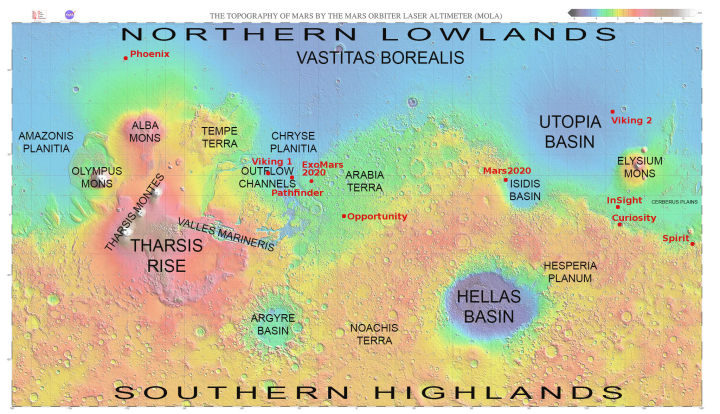Present and future landing sites on Mars
With InSight’s landing on Mars set for 11:54 am (Pacific) this coming Monday, November 26, 2018, I decided to put together a map of Mars showing the location of all the successful landers/rovers, adding the landing sites for the planned landers/rovers through 2020. This will give some context to InSight’s landing site.

The map does not show the landing sites for the failed Soviet, American, and British landers.
As I noted in describing the Mars2020 landing site, the location of the bulk of these landing sites, along the transition zone from the southern highlands and the northern lowlands, demonstrates the areas of the planet that interest geologists the most. It is here that we find many shoreline features, suggestive of the ocean that many scientists theorize existed intermittently in the northern lowlands. It is here that planetary scientists can quickly gather the most information about Martian geological history. And it is here that they have the opportunity to study the widest range of rock types.
From an explorer’s perspective, however, this approach has its limits. It does not provide us a look at a wide variety of locations. It is not directly aimed at finding lower latitude locations where ice might actually exist. And it is decidedly not focused in studying the planet from the perspective of future colonists. I am sometimes frustrated that we have as yet no plans to send any rovers into Marineris Valles, or to the western slopes of Arsia Mons, the southern most volcano in the chain of three giant volcanoes where there are indications that ice might exist underground, or to any of the places where caves are known to exist where a colony could be built more easily. In fact, the caves on the slopes of Arsia Mons seems a prime exploration target.
Eventually these locations will be explored, likely by private landers aimed at scouting out locations for future private settlements. I am just impatient.
On Christmas Eve 1968 three Americans became the first humans to visit another world. What they did to celebrate was unexpected and profound, and will be remembered throughout all human history. Genesis: the Story of Apollo 8, Robert Zimmerman's classic history of humanity's first journey to another world, tells that story, and it is now available as both an ebook and an audiobook, both with a foreword by Valerie Anders and a new introduction by Robert Zimmerman.
The print edition can be purchased at Amazon or from any other book seller. If you want an autographed copy the price is $60 for the hardback and $45 for the paperback, plus $8 shipping for each. Go here for purchasing details. The ebook is available everywhere for $5.99 (before discount) at amazon, or direct from my ebook publisher, ebookit. If you buy it from ebookit you don't support the big tech companies and the author gets a bigger cut much sooner.
The audiobook is also available at all these vendors, and is also free with a 30-day trial membership to Audible.
"Not simply about one mission, [Genesis] is also the history of America's quest for the moon... Zimmerman has done a masterful job of tying disparate events together into a solid account of one of America's greatest human triumphs."--San Antonio Express-News


I’ve always wished they would put a rover down in Mangala Valles. That place has had water flooding several times and lava as well combined with weather to probably show layering.
brightdark: I don’t know if you know this, but in my science fiction book, Pioneer, I placed my U.S. Martian colony inside Mangala Valles. And I made that decision back in 1985, based on the limited information available from the Mariner 9 and Viking orbiters.
Bob, If we did have a lot more landers/rovers, wouldn’t we come up against a wall in terms of operations as the Deep Space Network is almost maxed out? It seems to me that we need to invest in infrastructure in terms of updates and expansion of the DSN, but I never hear it mentioned. Your thoughts, please?
Col Beausabre: You are partly correct. However, I expect once private rovers start arriving, they will come with their own very inexpensive and efficient communications arrangements. In fact, InSight is testing this with its two MARCO cubesats, set to fly by Mars as the lander is coming down and designed to relay info to the ground, quickly. It is an engineering test, but I think it predicts a future of many cubesats providing this communications service.
Also, wouldn’t it make sense for someone to develop a basic, no frills rover that you could sell with the idea the customer would provide the instruments he needs for his mission? It would have a power source, guidance, power train and communications (perhaps optional if the customer wanted his own) with a number of standard mounting points (think Picatinny Rails in space) incorporating power and data hookups for his instruments.
Col Beausabre: See these two BtB posts, both posed in the last two weeks:
The first post especially is directly related to your concepts. Their rover is certainly not up to snuff, but their concept is right on the money: Simplify the design so that each small rover can do a central basic task. Standardize the design as well.
This is the future, and it will be private enterprise that will do it. Or else later generations will be waiting a long time to final wander about on the Martian landscape.